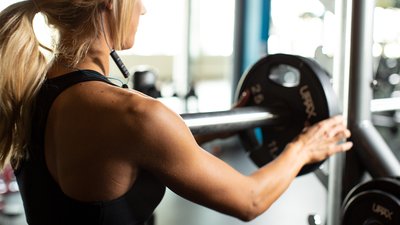I can't recall how many times I've heard Ronnie Coleman's classic line echo around the weight room: "Everybody wants to be a bodybuilder, but nobody wants to lift no heavy-ass weight." I'd say the over/under is around a thousand. And the reason is because he's pretty much right.
Ronnie shouted out the quote when he was about to step under a loaded bar for the squat, but for me, the line especially rings true for the deadlift. This is why I created my twist on Ronnie's famous line: "Everybody wants to deadlift, but nobody wants to hip hinge correctly." I find that saying that in my Ronnie voice helps it resonate more powerfully with clients.
Here's the thing: The deadlift gets overanalyzed by most lifters, which leads to butchered execution. The answer isn't to memorize every cue that ever helped a pro powerlifter and then try to remember them all when you stand on the platform. The answer, quite simply, is to master the hip hinge first, and then build your deadlift around that strength.
Spend some quality time fortifying your hip hinge—both when you're starting out and when you're more advanced—and you'll spare your back and build a powerful set of hips and legs that will help you in every other lower-body movement. And you'd better believe it'll help you lift some heavy-ass weight, too.
The Hip Hinge: A Visual Allegory
It sounds like something your grandma wears to get out of the bath tub, but the hip hinge is actually an important fundamental human movement that everyone should master. The squat may be the so-called "king of lifts," but the hinge is perhaps more important in the long-term performance and functionality of everyone from elite athletes to physical therapy patients, elderly people seeking more functionality, and every gym-goer in between.
Barbell Deadlift
In actual practice, hip hinging means moving the hips through a complete flexion (closing) to extension (opening) cycle, while limiting movement at other joints. It's a precursor to all lower-body movements, but specifically the deadlift, squat, and most Olympic lifts. Hip hinge mastery isn't optional to move well with heavy loads—it's necessary.
Nevertheless, while most people can picture a squat, many have trouble imagining a hip hinge in their mind. So to start, picture a door hinge. The joint in the middle rotates while the side brackets remain rigid. This, in a nutshell, is how hip hinging works. The torso is braced and held rigid on the north side of the hips. Below the border, there's a relatively stiff lower-body guided by hamstring tension. The only dramatic movement is at the hips.
Hammering Home the Hinge
There are a number of problems that can get in the way of a good hip hinge. Some folks simply have poor hip mobility, which can be caused by a congregation of factors including poor core stability and inflexible hamstrings. Hip capsules can also suffer from excessive tightness.
Meager hip mobility reduces the ability to solidify the hinge and causes the spine and knees to compensate for the lack of movement, which is inefficient and potentially injurious. If your immobility is the real hurdle, a solution beyond the scope of this article is necessary.
However, apart from the raw material issues just mentioned, most trainees are simply never taught how to hinge and need instruction with sound cues. They fail to hinge properly because they can't understand how to separate movement in the spine from movement in the hips. If that's the case for you, try these drills to teach spinal awareness; send your butt in the right direction.
1. Cat-camel drill
3 sets of 5 reps, each direction
The cat-camel drill, as taught by Dr. Andreo Spina and his Functional Range Conditioning system, is your starting point.
The key of the drill is to move each spinal segment separately, creating a strong connection between your brain and the peripheral nerves that create spatial awareness. It's the most effective technique I use to teach the difference between the spine and hips.
Any trainee, regardless of how advanced they are, can benefit from the cat-camel drill.
2. Kneeling hip hinge with PVC
3 sets of 8 reps
After building basic spine and hip awareness, it's time to begin building the hinge from the ground up with the kneeling hip hinge. Kneeling reduces the amount of moving parts, allowing for an increased focus on torso rigidity and hip movement. The PVC pipe teaches what a neutral spine feels like and how to maintain it.
Kneeling Hip Hinge Watch The Video - 00:31
3. Standing hip hinge with PVC
3 sets of 8 reps
Once you've got the floor version down, take the kneeling hip hinge to your feet. The wall gives you a marker to hit and measures progress. When you master driving the hips back, step away from the wall and do it in free space. When you master the hip hinge in free space, remove the PVC and maintain a neutral spine.
Standing Hip Hinge Watch The Video - 00:25
4. Belly swing
3 sets of 8 reps
Now it's time to add tension. This exercise comes from legendary strength and track coach Dan John, who calls it the "Bulgarian goat belly swing," a noble name for an honorable exercise.
You can perform it with a kettlebell, dumbbell, sandbag, or weight plate. Start by taking a deep belly breath, and follow that by bracing your abdominals tightly. When you're tight, pull the weight firmly into your braced abs. The result is a strong upper back and lat contraction teeming with deadlift power. Then push the hips back like in the butt-to-wall.
Hip Hinge Programming
All lifters, from steadfast iron devotees to people newly baptized by barbells, can benefit from remedial hinge work. An advanced lifter might not need the same proportion of drill work, but they ignore it at their peril.
This basic template will help you formulate proper hinge form and will get you moving in the right direction with solid back tension, grace, and power. Weight room vets can do well by using this as part of a warm-up or as an off-day recovery method. Newbies should use this in the place of deadlift training until their hinge is strong and confident.
Just remember: Happy hinge, happy deadlift, and happy back.


